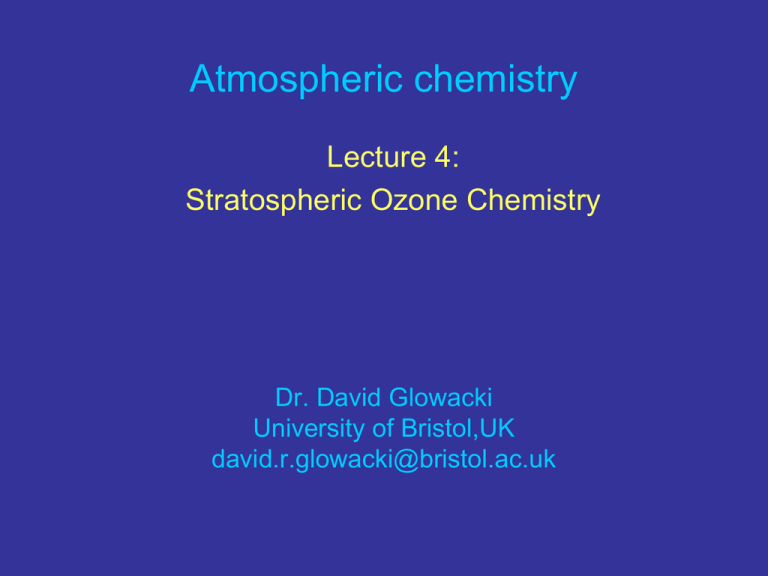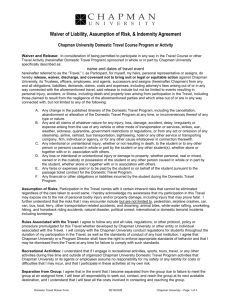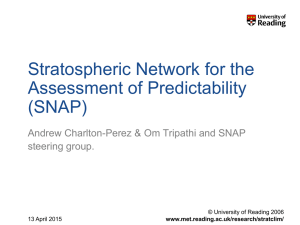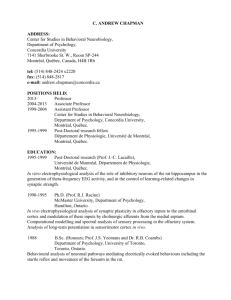Glowacki-AT207
advertisement

Atmospheric chemistry Lecture 4: Stratospheric Ozone Chemistry Dr. David Glowacki University of Bristol,UK david.r.glowacki@bristol.ac.uk Yesterday… • We discussed tropospheric chemistry • The troposphere is a massive chemical reactor that depends on pressure, temperature, sunlight, and ground level chemical emissions Today… • We will discuss some of the chemistry in the stratosphere • Stratospheric chemistry is a little bit simpler than tropospheric chemistry because there’s less pollutants • Also, the molecules involved are smaller so there’s fewer branching reactions Integrated column - Dobson unit Atmospheric O3 profiles • In the 1920s, observations of the solar UV spectrum suggested a significant atmospheric [O3] O3 altitude profile measured from satellite • At the ground: [O3] ~ 10-100 ppb • In the stratosphere: [O3] ~ 5-10 ppm The Chapman Cycle O2 + hv O + O O + O2 + M O3 + M O3 + hv O2 + O O3 + O O2 + O 2 (4) (1) (2) (3) Chapman Cycle Step 1: O2 + hv O + O O2 O(3P) + O(3P) - Threshold < 242 nm O2 O(3P) + O(1D) - Threshold < 176 nm Chapman Cycle Step 2: O + O2 + M O3 + M M O OO M = O2 or N2 O3 O + O2 reaction coordinate UV absorption of O+ 298 KO + O 3 at Chapman Cycle spectrum Step 3: O hv 3 2 λ < 336 nm Hartley bands Very strong absorption Small but significant absorption out to 350 nm (Huggins bands) Photolysis mainly yields O(1D) + O2, but as the stratosphere is very dry (H2O ~ 5 ppm), almost all of the O(1D) is collisionally relaxed to O(3P) UV absorption spectrum O3 at 298 Chapman CycleofStep 4 K O3 + O O2 + O 2 Occurs via an abstraction mechanism The Chapman Cycle O2 + hv O + O O + O2 + M O3 + M O3 + hv O2 + O O3 + O O2 + O 2 (4) Rate coefficients for each reaction have been measured in the lab (1) (2) (3) Solving for [O3] using the Chapman Mech (1) (2) (3) (4) (B1) (A1) (A2) k1[O2 ] [O] k 4 [O3 ] Substitute (A2) into (B2) k1k2 1/ 2 3/2 [O3 ] C n O2 a k k 3 4 [O] k3 [O3 ] k 2 [M ][O2 ] [M] n a (B2) (na is the atmospheric number density) [O2 ] CO2 n a (CO2 is the O2 mixing ratio) How good is the Chapman mechanism? k1k2 1/ 2 3/2 [O3 ] [O2 ]n a k3 k4 • Determining stratospheric [O3] using the above Chapman equation isn’t entirely straightforward because k1 and k3 are photolysis rates! k1 j1 A (,T)A (,T)I()d where and k1 & k3 are photolysis rates Beer Lambert Law Atmospheric optical depth How good is the Chapman mechanism? Altitude Increasing photolysis with altitude Chapman overpredicts by a factor of 2 The maximum reflects k1, which is affected by: (1)Decreasing [O2] with altitude following the barometric law (2)Increasing hv with altitude k1k2 1/ 2 3/2 [O3 ] [O ]n 2 a k3 k4 Q: Why does Chapman overpredict? A: Catalytic Ozone loss cycles Catalytic ozone destruction The loss of odd oxygen can be accelerated through catalytic cycles whose net result is the same as the (slow) 4th step in the Chapman cycle Uncatalysed: O + O3 O2 + O2 k4 X is a catalyst Catalysed: X + O3 XO + O2 k5 and is reformed XO + O X + O2 k6 Net rxn: O + O 3 O2 + O 2 X = OH, Cl, NO, Br (and H at higher altitudes) Reaction (4) has a significant barrier and so is slow at stratospheric temperatures Reactions (5) and (6) are fast, and hence the conversion of O and O3 to 2 molecules of O2 is much faster, and more ozone is destroyed. Using the steady-state approximation for XO, R5=R6 and hence k5[X][O3] = k6[XO][O] Rate (catalysed) / Rate (uncatalysed) = R5/R4 = k5[X][O3]/k4[O][O3]= k5[X]/k4[O] Or Rate (catalysed) / Rate (uncatalysed) = R6/R4 = k6[XO][O]/k4[O][O3]=k6[XO]/k4[O3] Catalytic ozone loss kinetics k5 (220K) k4 k6 (220K) • X+O3 (k5) and XO+O (k6) are up to a factor of ~104 faster than O + O3 (k4)! • A little bit of XO makes a big difference! Catalytic O3 loss via HOx • OH is an even more efficient catalyst because the intermediate HO2 also destroys O3 • OH in the stratosphere is generated in the same way it is generated in the troposphere Catalytic O3 loss via NOx Predominant fate of stratospheric NO (null cycle, no net change) A small fraction of NO2 reacts with O Catalytic Loss Cycle Loss of stratospheric NOx • Primarily via formation of HNO3, transport to troposphere, & deposition daytime nighttime • HNO3 & N2O5 are NOx ‘reservoirs’ • Very stable & have a long lifetime N2O: another source of stratospheric NOx • Because the N2O lifetime is very long, it may be transported to the stratosphere, where it undergoes the following: • Consideration of N2O brings the Chapman model into much better agreement with observations • Ice Core data show increase of atmospheric [N2O] of ~0.3% year since 18th century Some complications to stratospheric O3 chemistry • Catalytic Loss cycles are coupled to each other • Aerosols









